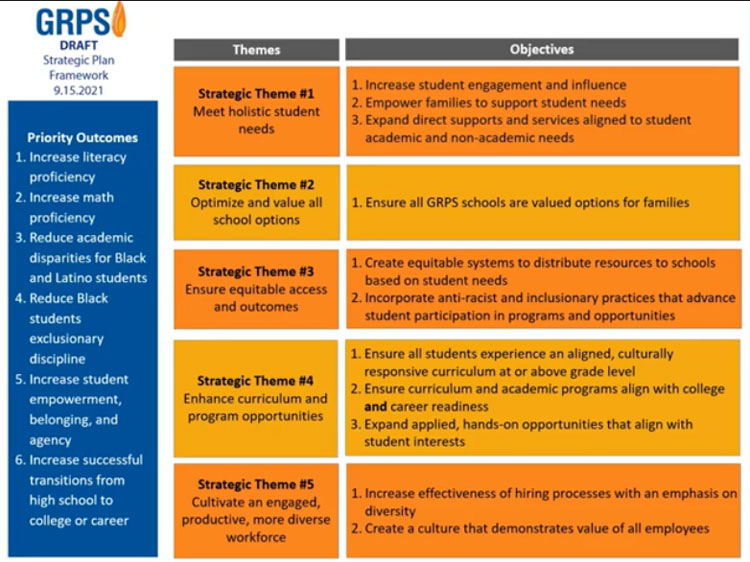Grand Rapids — With the 2021 Strategic Plan, Superintendent Leadriane Roby is helping Grand Rapids Public Schools build on the 2012 Transformation Plan and “chart a new course” to address the growing changes in the community.
After reviewing community input over the past two months, a strategic planning framework was to be presented to the GRPS school board for discussion and approval today, Nov. 8. For a more detailed analysis of the findings, visit the plan outline on the GRPS website.
“We want to make sure we change the narrative of our district because we want to ensure positive experiences when people work with our schools,” Roby said at Southwest Middle High School — Academia Bilingue community input session on Oct. 12. “We want our people to feel connected and a sense of belonging no matter who they are.”
In 2012, former GRPS Superintendent Teresa Weatherall Neal toured the district to ask community members for their feedback on problems, barriers and potential solutions to the school system’s challenges. The process produced a comprehensive plan to restore stability and growth to GRPS schools, which officials say contributed to increased graduation rates, rising test scores and a 25 percent decline in chronic absenteeism.
Multi-stage Strategic Planning Process
• Phase 1, May-August: A current assessment and analysis of GRPS.
• Phase 2, September-January: Draft a framework for the strategic plan, including a vision, priorities for students, themes and objectives and a reporting process to measure progress and report back to the community.
• Phase 3, January-March: Create specific action plans.
The new Strategic Plan aims to build on that success. The district hosted six community input sessions throughout September and October for students, parents, staff, and the general public to provide feedback on the proposed plan. Community members were presented with a PowerPoint presentation outlining a draft framework for the Strategic Plan.
Roby opened the Oct. 12 session by going over the summary and analysis of the findings from the phase one assessment. The PowerPoint showed that in grades 3-7, African-American, Hispanic and Native American students trail their white peers in both English and math. The same holds true in SAT scores. And while improved GRPS graduation rates compare favorably with other large Michigan districts, its college-going rate lags state and national averages.
“It is important to understand how different types of students are performing in GRPS,” Roby said. “We wanted to examine how race, ethnicity and income influence student success.”

Stakeholders Weigh In
Community stakeholders, including parents, teachers, business owners, students and faith-based organizations, identified GRPS’ strengths including community partnerships, pride and support, teachers and staff, and school choice programs.
Their suggested improvements included employee hiring, orientation, retention and support; inequity in funding and resources; issues of racism, diversity and inclusion; college and career preparation; and defining student success.
‘We want to make sure we change the narrative of our district because we want to ensure positive experiences when people work with our schools.’
— Superintendent Leadriane Roby
A GRPS diversity and equity team also drafted a GRPS Equity Vision Statement for community review at the input sessions.
Each breakout group discussed what they thought worked well within the Strategic Plan, what they disagreed with, if anything was missing and new ideas for approaching solutions.
At the beginning of one breakout group discussion, a GRPS parent asked, “How the heck do they think they’re going to pull off these tremendous goals?” To which the small group’s moderator responded: “I try to step back and think about the ‘how’ for all of our goals (and) take the next step, baby steps in the process.”
On the Vision Statement
A parent of a kindergarten student said she appreciated their attempt “to include all identities, races, genders, orientations and religions. Times are changing and [GRPS] understands that.”
During the virtual session, Cara Glass, a pre-K teacher at Buchanan Elementary, also praised the specific language used in the vision statement.
“I really appreciate the specificity about how we are being inclusive as a district, listening to many marginalized communities, expression identities and I’m grateful to see this language specifically listed,” she said.
On Priority Outcomes
Roby explained the six priority outcomes GRPS will focus on over the next five years, including addressing math and literacy proficiency, reducing disparities for students of color and increasing student empowerment.
“While student success will always be addressed, these six emerged as the most important based on stakeholder input,” she said.
Responses from small groups praised the recognition of “students’ humanity in addition to academics” and an emphasis on academic disparities for students of color that have existed for a very long time.
Other areas of growth discussed in small groups were improving communication and access to information at the school and district levels, “messy” transportation issues, and teacher retention and diversity.
The kindergarten parent at Southwest Middle High said she was “ thrilled with the education my child is getting” and said GRPS teachers are the “district’s best asset.”
Still, participants from the virtual session agreed it was “important for teachers to mirror who they’re serving and the community their students are from.” While 72 percent of district students are Hispanic or African American, only 9 percent of their teachers are, GRPS figures show.













